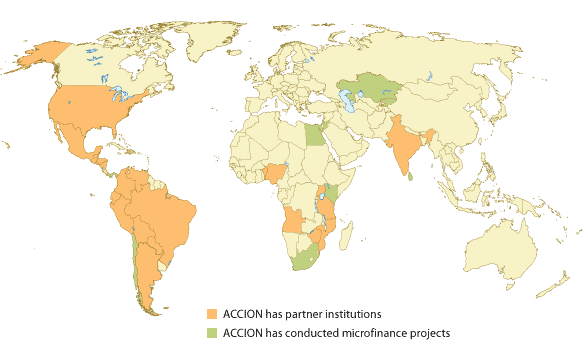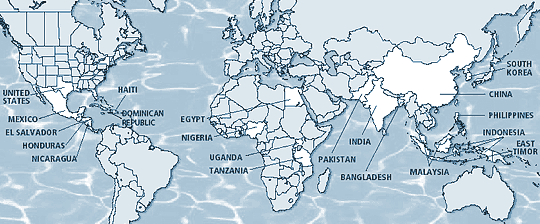

  |
|
last modified: Sunday, December 18, 2005 9:24 PM |
|
Group Lending: Learning from the International Experience |
|
Elizabeth Delgado |
email lizzyd@umich.edu |
INTRODUCTION
This paper will examine the international microfinance group lending model, successful existent versions of this model in the United States, and the model’s applicability in a Post-Katrina New Orleans. This entry will be broken up into three sections. The first section will give a general background of the microfinance and group lending movement, popularized in the developing world in past decades. The second section will explore successful examples of the group lending model in the United States and evaluate the challenges of its implementation in the world’s most developed country. The third and last section will be dedicated to evaluating the feasibility of the group lending model in New Orleans after Hurricane Katrina. Please note that all three entries will be made as separate entries, but are all subsequent to each other.
I. Microfinance and the Group Lending Model
MICROFINANCE & MICROCREDITING
Microfinance is the practice of extending small loans to the poor (also known as a micro-loan) for income-generating activities often coupled with other financial services such as savings and insurance. In the 1970s, the lack of perfect information between borrowers and lenders, specifically surround the borrowers ability to repay the loan was researchers’ (including that of Grameen’s) impetus to fill the void for the poor to be able to access to small loans (typically not available from lending institutions). Thus the concept of a micro-credit was first introduced by the Grameen Bank in Bangladesh and ACCION International in Latin America, where they worked in both urban and rural areas for borrowers unable to tap into financial capital and institutions. [For more information on micro crediting, please refer to Gregory Claxton’s Entry]
THE CASE FOR GROUP LENDING

The most powerful innovation of the Grameen Bank’s micro lending model was its reliance on a novel group-lending scheme that reduced transaction costs to the lender and drastically improved repayment rates. Group lending is a type of micro credit that was pioneered in Bangladesh by Grameen Bank and by ACCION International in Latin America. It has been said to be one of the most powerful tools in third world development making credit available to people who lack the access to formal financial markets.

What happens though in the group lending model is that instead of lending directly to individual borrowers, banks lend to groups of borrowers, who are jointly liable for a single loan. In the developing world, group lending served several mutually reinforcing purposes that have been well documented both historically and through economic game theory. Group lending minimized administrative and transaction costs for lenders by replacing credit checks and collateral processing with self-selection of groups by borrowers. Borrowers, who were jointly liable for the loans of their group, had a vested interest in choosing trustworthy partners. Joint liability also discouraged default because group members exercised peer pressure to repay on their partners, as well as providing a business support network that offered advice, connections, and potential markets.
The extent to which the group lending model has been able to generate revenue, while at the same time helping small businesses and communities at the same time is a phenomenon within the financial community within itself. The model works generating revenue through interest in which is paid by each borrower to help finance the cost of lending to another. Such a model can lead to self-sustaining microlending programs that cover their own costs. A ‘successful’ program will generate more resources with each individual helped because of added interest enables program to generate more income than they actually spend- hence helping more people in need. These mechanisms towards self sustaining and even profit making ventures, has led some banks to be both profitable and serve the world’s poor.
The group lending model also provides avenue for the areas served to build upon the richness in social capital that enhances the trust and peer pressure factor important in the group lending scheme, though this has been found to have little significant effect on the performance of borrowing groups. But the mechanism that has been said to be the most important in its success has been peer monitoring- the ability of borrowers to monitor each other’s investment behavior during the course of the loan. Peer pressure has shown to be the second most important factor in its success- if borrowers are unable to threaten their borrowers with expulsion from the group, there is a greater chance of misused borrowed capital, for instance. Additionally, peer pressure becomes an incentive to not default or not having others default, because of knowledge that if one group member defaults, then the other members of the group will have to make up the interest payment of that specific member.
There is also much discussion about the various roles, benefits and costs that group lending has in serving the most poor, or entire societies. This debate has been crucial in molding the idea of group lending, from its original established by Grameen, and its role in providing opportunities for people in transitioning economies, for example.
Challenges:
· Latin American affiliated from ACCION International (highlighted below) are moving their full costs, but are said to not serve as poor a client as ‘originally’ intended;
· Group
lending can be costly to implement- and neither Grameen or other
poverty relief focused programs are
not fully cover costs, meaning that borrowers have to also cover
the remaining costs or that they are charged excessive interest rates;
· Monitoring and group meetings- characteristic of group lending techniques- can be too costly and inconvenient, especially in rural areas where homes are not close together;
· Lack of evidence showing that there are programs that are tied to group lending programs that help individuals be economically self sustaining (without the micro credit), or tied to basic social and infrastructure services that enable them to improve their situation.
· Not recommended for transitional economies, like most Eastern European countries transitioning to capitalist societies, because of costs in targeting mainly wealthier borrowers- it because more cost-effective to target individuals at this point and not groups.
Strengths
· Shifts the risk of the loan from the bank to the group, because they are financially liable for one another’s loans;
· The eventual increase in disposable income can lead to economic development and growth;
· In the Grameen model, groups are self-selected so it may have a peer pressure effect- with the idea that if the borrowers in the group know each other, they would be more accountable;
· Close communal ties that can create group pressure;
· Groups can equally succeed in:
o Rural areas where grouping occurs ‘assortatively,’ where people are more selective in forming partnership in a group. Such groups tend to be highly homogeneous.
o Urban areas: borrowers engage in-group formation in ‘non-assortative,’ where therefore the borrowing population is highly heterogeneous and groups can be based on a variety of traits.
PROMINENT GROUP LENDING INSTITUTIONS

There are two organizations, in particular, that have been the leaders in helping people starting their own businesses, both internationally and domestically. They not only provide technical assistance for individual and groups seeking to become involved with micro-credit institutions, but also provide a variety of financial products. Below is a short introduction to each organization, as well as a list of products they offer.
GRAMEEN BANK
The Grameen model has been a model throughout the world for alleviating poverty for hundreds and thousands of people. Paralleling the start of the micro-financing system in the 1970s, Grameen bank started in 1976 by Professor Muhammed Yunus and his colleagues in Bangladesh. The Grameen bank is not exclusive to microfinancing activities but has ventured into non-banking activities such as venture capital, the textile industry, an internet service provider, and much more—all known as the Grameen Family of Organizations.
Grameen
Banking Model is based on the voluntary formation of small groups of
five people to provide mutual, morally binding group guarantees in
lieu of the collateral required by conventional banks. With over 90% of borrowers
being women, group lending provides an opportunity for the creation of
collective income generating activities- such as pottery, garment sewing,
transport services, and the list goes on. The impact of women has
become the most notable, as experienced by Grameen. The result
for women in third world countries,countries has been a heightened
status, lessened dependency on husbands and improvement of homes and
nutritional standards for their children because they have more control
over the spending patterns in the household. The landless have
also benefited the most from group lending, resulting in sharp reduction
in the number of Grameen members living below the poverty line (20%)
compared to 56% for comparable non-Grameen members.
Below is a list of statistics indicating the impact of Grameen’s products, contrary to what conventional banks thought possible:
· Repayment rates for poor reached 97%
· Women account for 94% of borrowers in early 1992.
· Groups savings, similar to group lending, has proven as successful as group lending;
· Group savings reached 7,853 million taka (USD $162 million);
· From 15,000 members in 1980, the bank has been able to expand to 100,000 within the span of 5 years;
· There are more than 66,581 centers of groups of which 33,226 are women;
Similar to many other international companies, Grameen has acknowledged that poverty extends beyond the developing world, and has established the Grameen Foundation USA, whose programs extend to India, China, Mexico and the Phillipines. See map of where the Grameen model has been established. The model of group lending and microfinance established by Grameen Bank founder Dr. Mohammed Yunus had definitely opened pathways to providing credit for the impoverished to be able to have an opportunity to use their capital to improve the lives of their families and their communities.
Founded in 1961 in an attempt to address the desperate poverty in Latin American cities, ACCION International began as a student-run volunteer effort in the shantytown of Caracas, Venezuela. It is now a private, non-profit organization providing financial tools such as micro enterprise loans, business training, and other financial services. Though the driving force behind ACCION’s mission remains the same, the organization has built a tradition of developing innovative solutions to poverty in partnering with lending institutions spanning throughout Latin America, The United States and Africa.
One
of ACCION’s noted accomplishments has been its ability to garner financial
resources and work with commercial banks in launching micro-financing
services directly. They have also been able to provide assistance for micro
financing institutions that have started as non-governmental organizations
to assist the poor, and have guided them towards becoming self-sustaining
micro financing institutions. Some examples of these include SOGEBANK (Haiti),
Banco del Pichincha (Ecuador) and Banco ABN AMRO Real (Brazil). Through
these MFIs is that ACCION has been able to use the group lending method
that seeks to be effective depending on the context of the countries geographical
expansion. ACCION has also been able to build on their
network by not only building on the number of countries within Latin
America, but expanded to Africa and Asia as well as to the United States
(link to Samara Freemark’s entry on group lending in the United States). See
map of networks. The group lending mechanism within ACCION has
been often called a solidarity group.
Below is a list of statistics of the impact of ACCION International:
· Since 1992, ACCION affiliated programs have made $7.6 billion in micro loans available to more than 4.7 million people, with a historical repayment rate of over 97%
· In 2004 alone, ACCION served more than 1 million active clients and lending more than one billion dollars.
· Loans range from as low as US $100
· 65% of clients are women
Additional Resources:
Vaitilingam, Romesh. “Group Lending: The Signficance of MicroCredit as a Tool of Third World Development.” July 1999.
The Economist (November 3, 2005) “The Hidden Wealth of the Poor.”
Unitus: Global MicroFinance Accelerator.
Grameen Bank Website. http://www.grameen-info.org/bank/index.html
Grameen Foundation USA. http://www.grameenfoundation.org
ACCION International Website. http://www.accion.org
ACCION Network – a network of established microfinance institutions around the world http://www.accionnetwork.org/members.htm#solidario